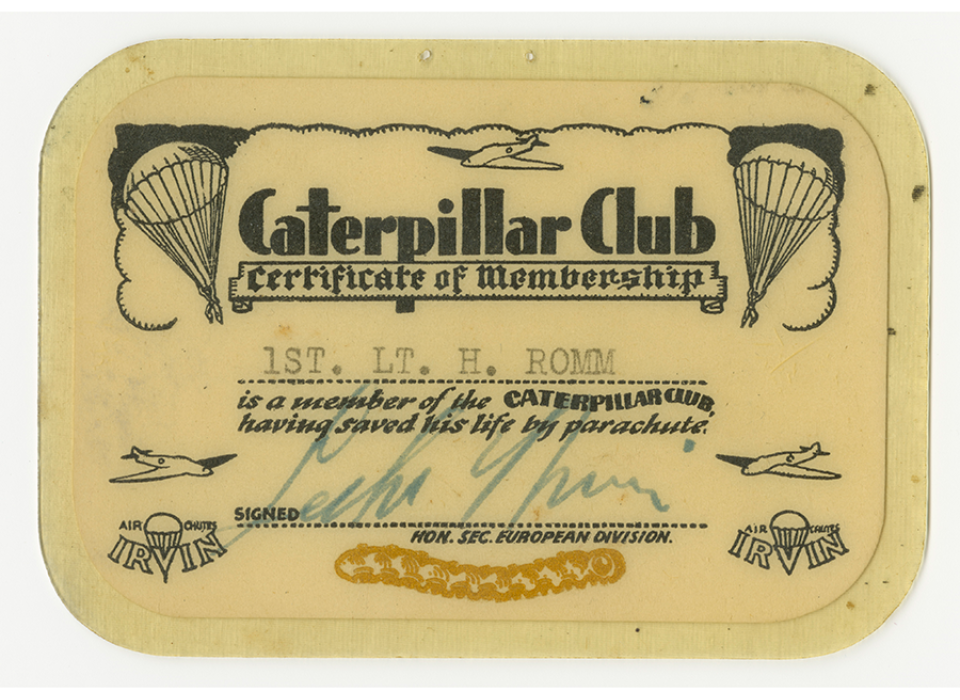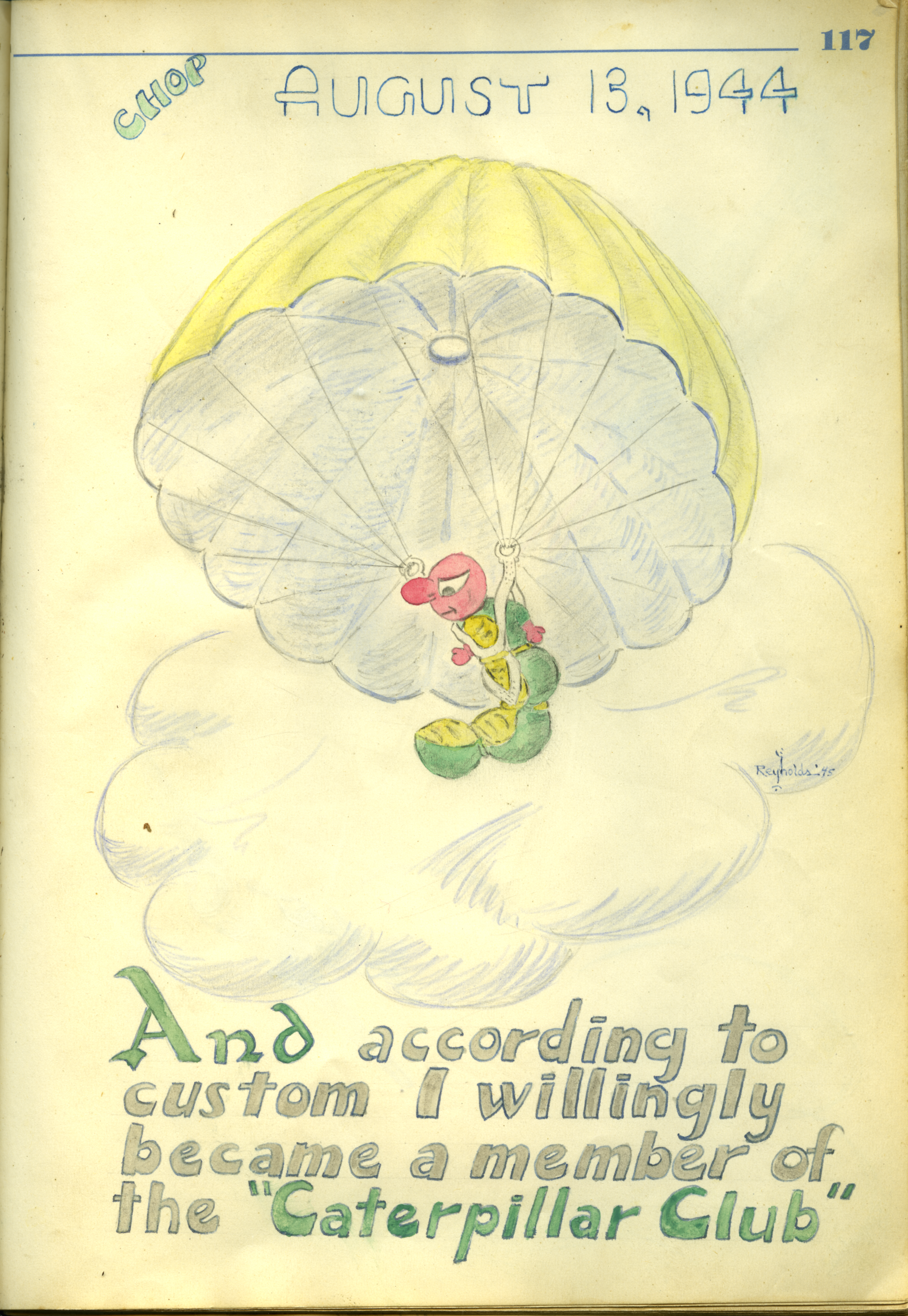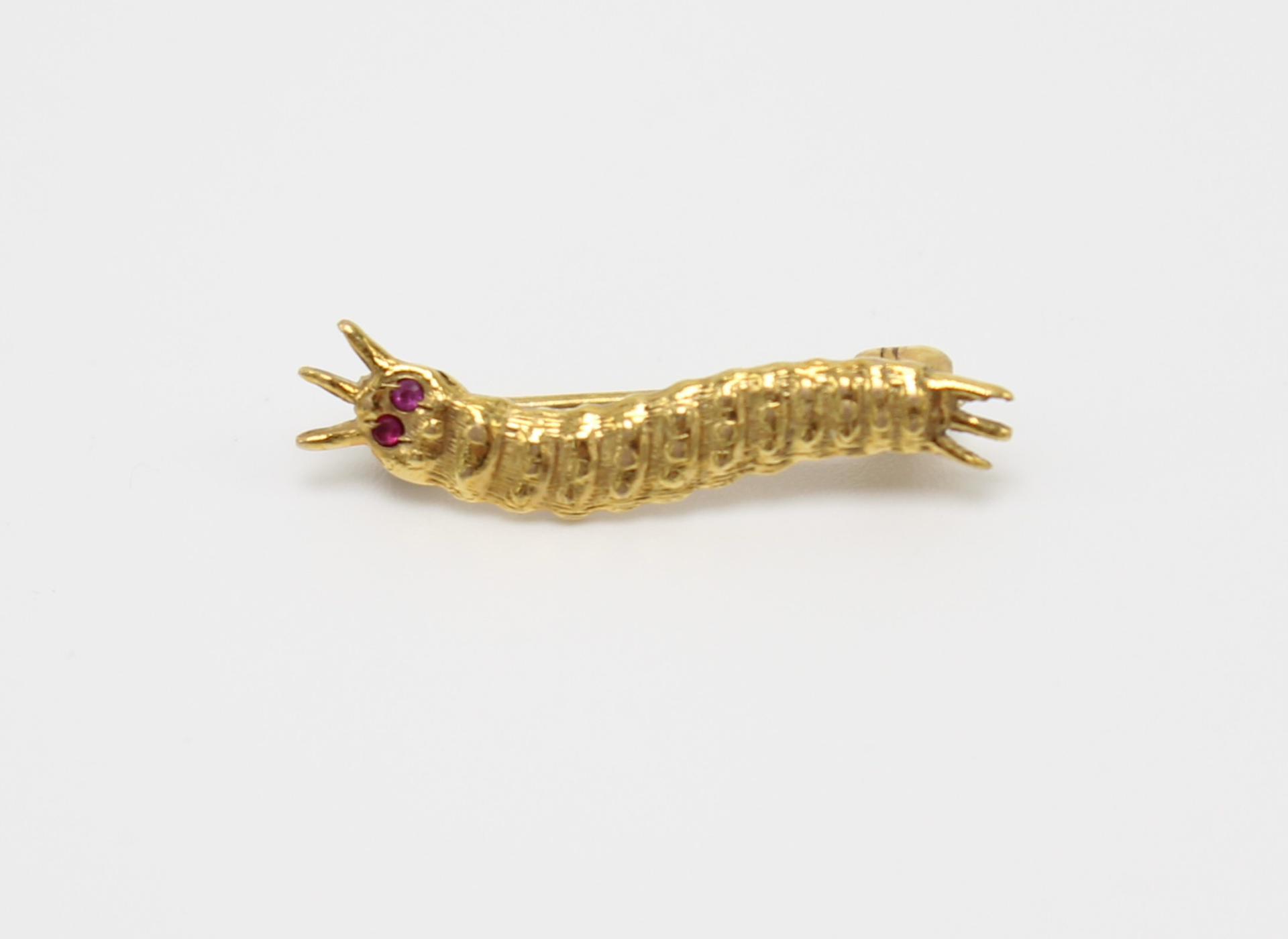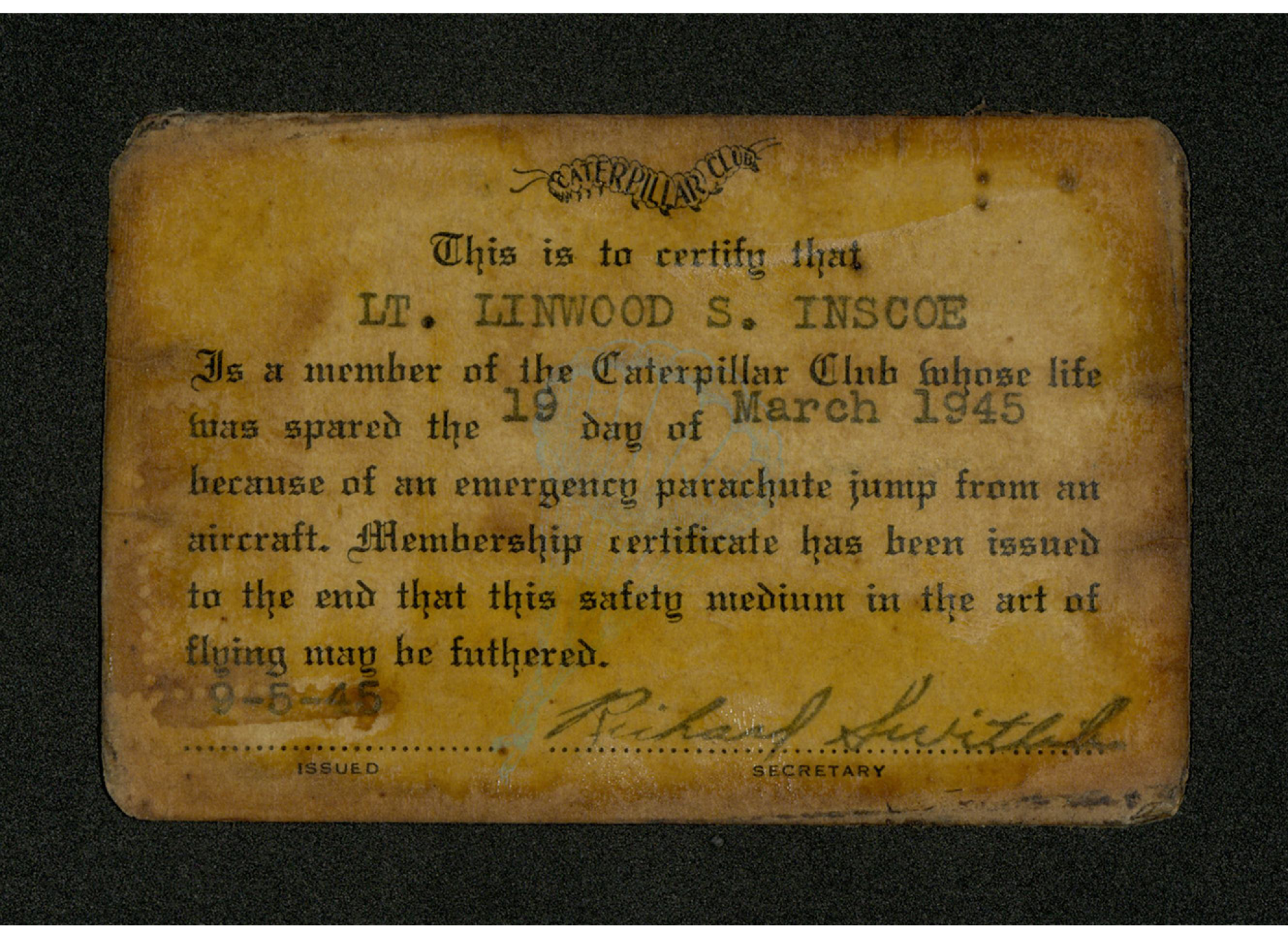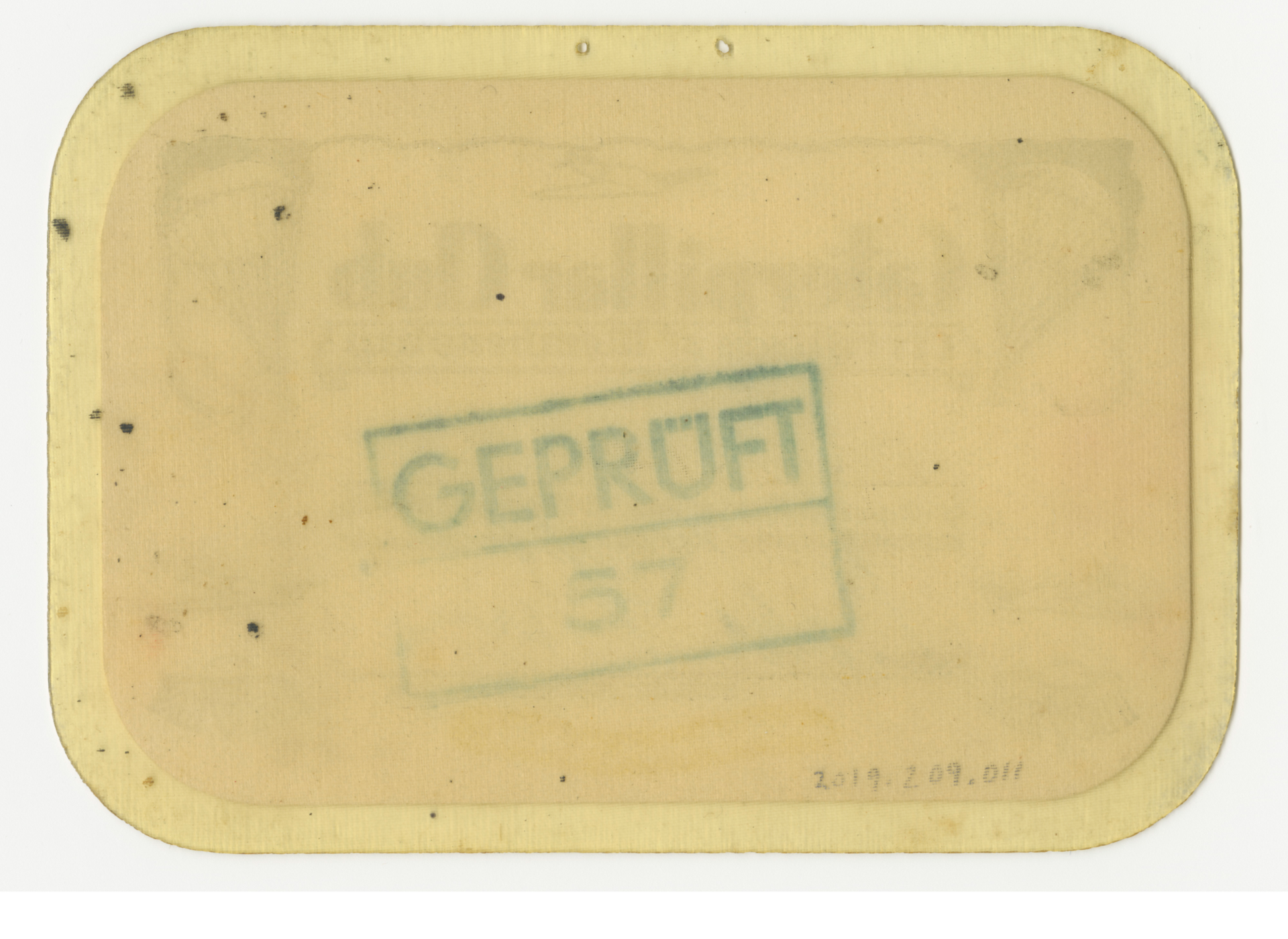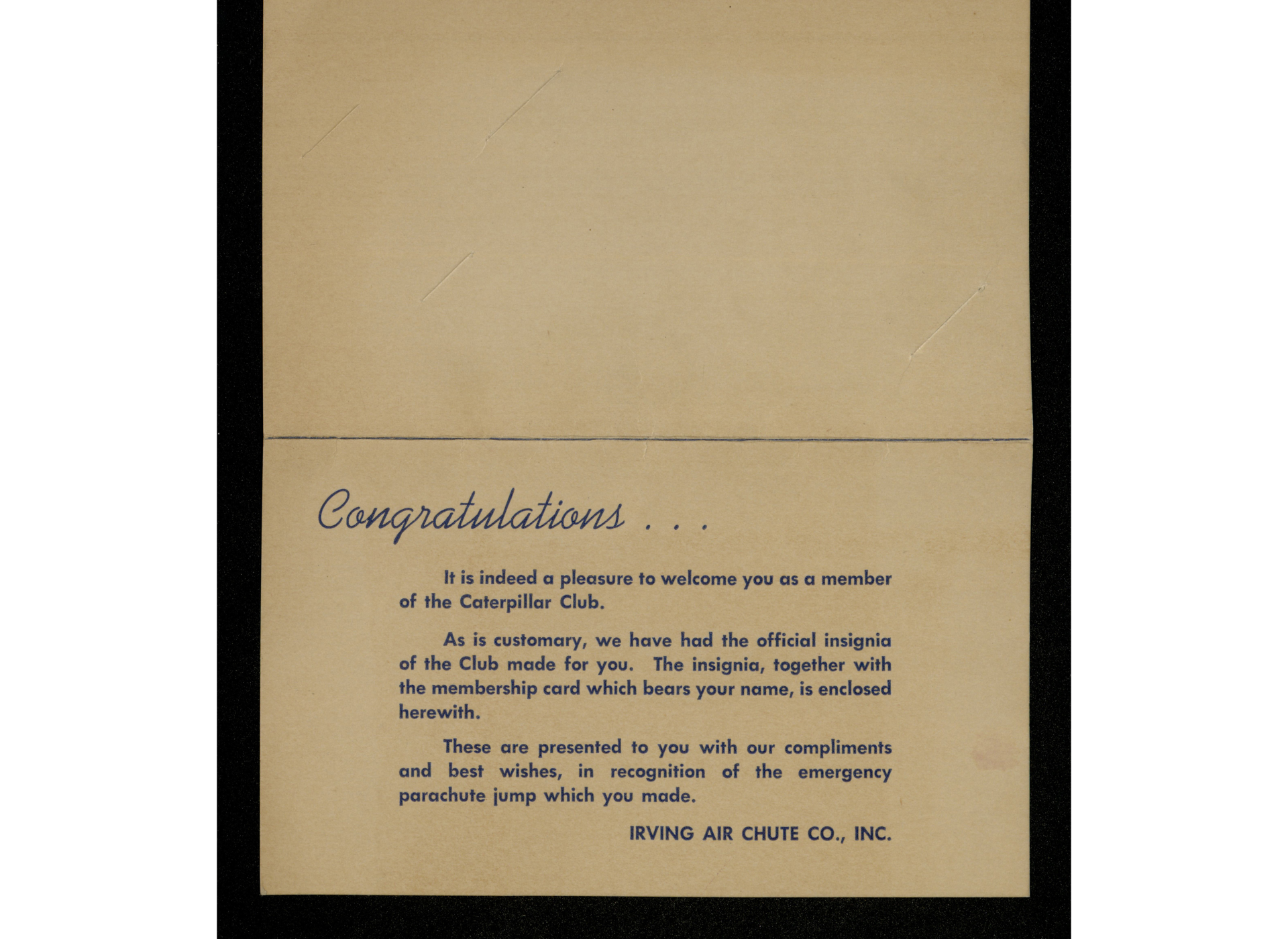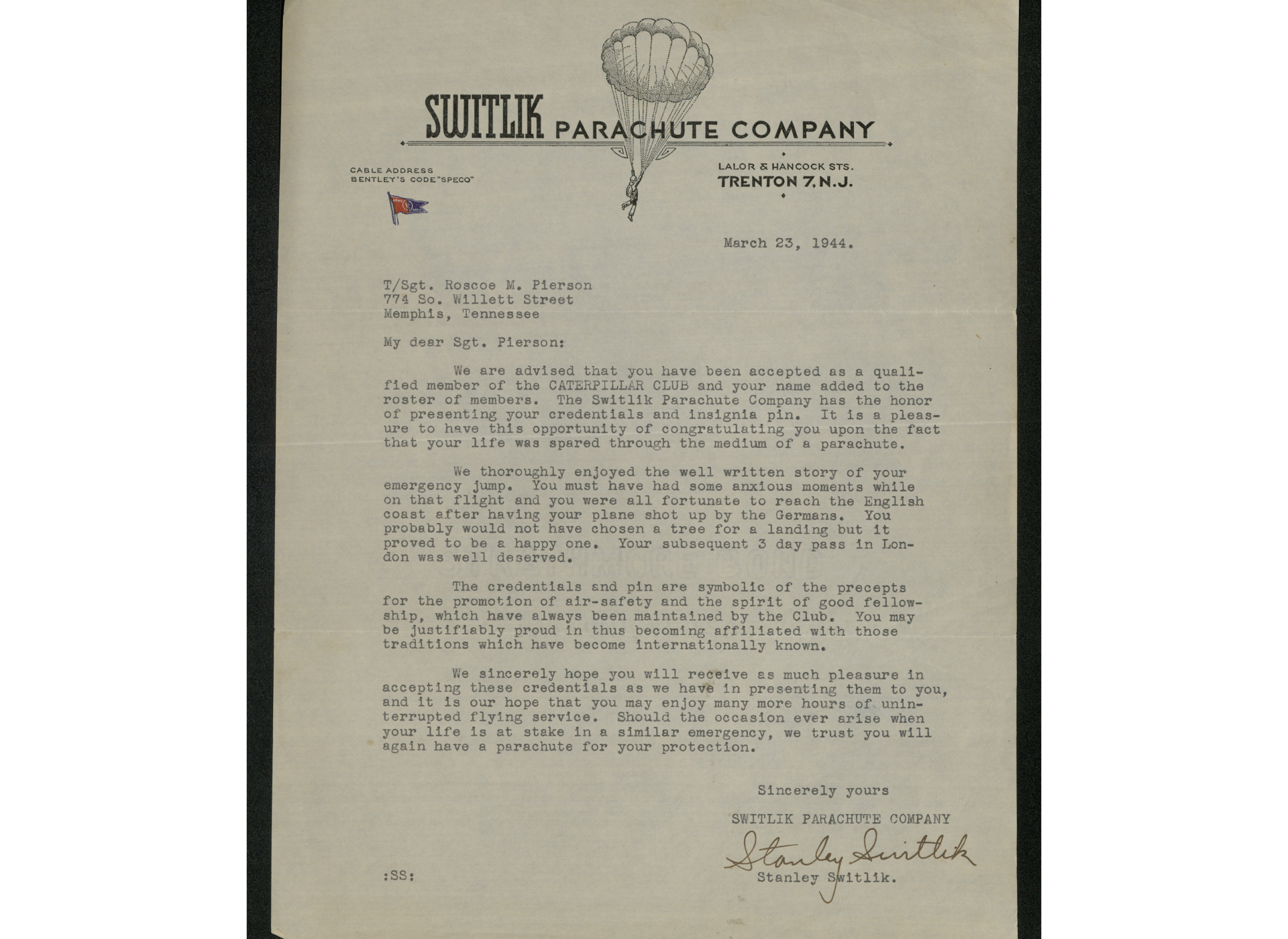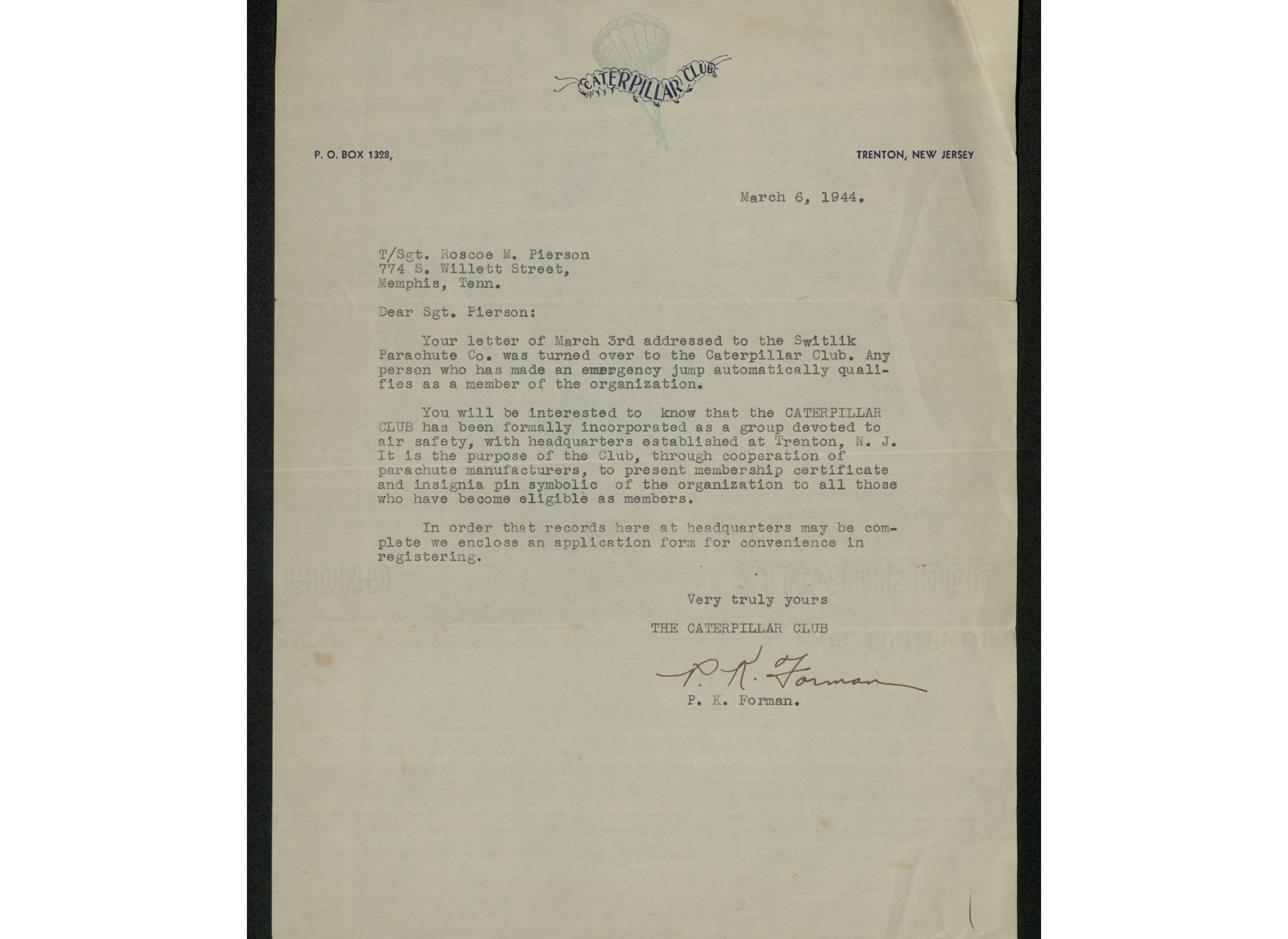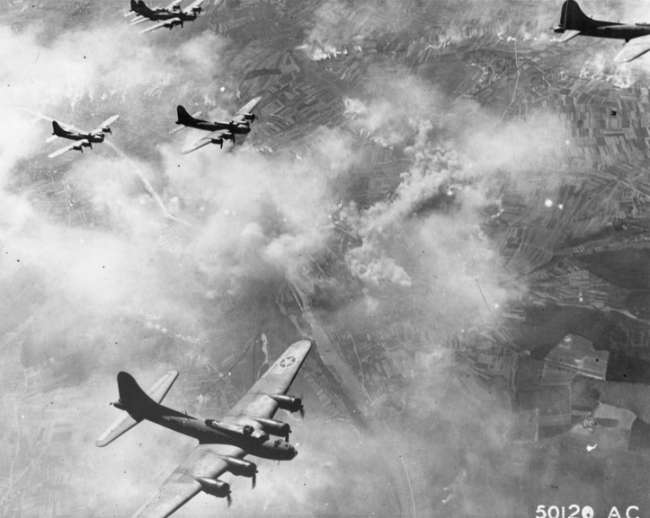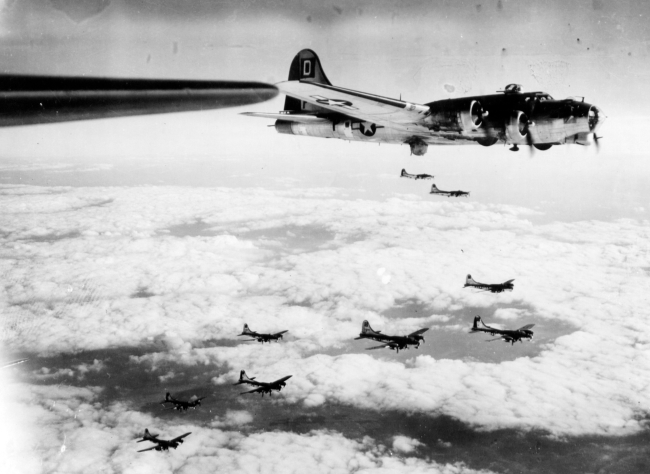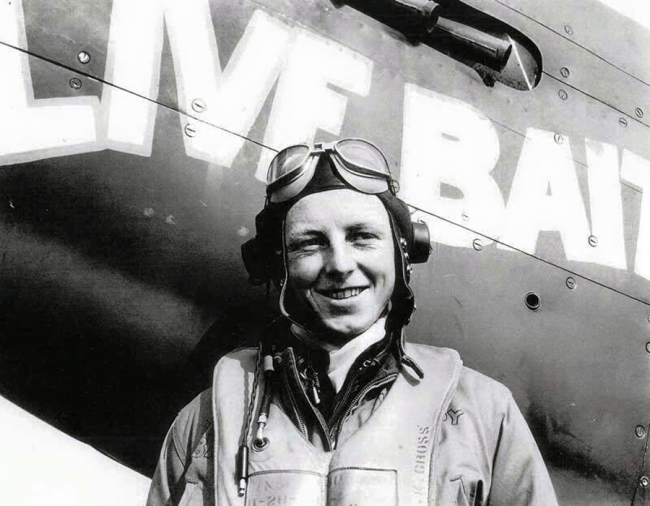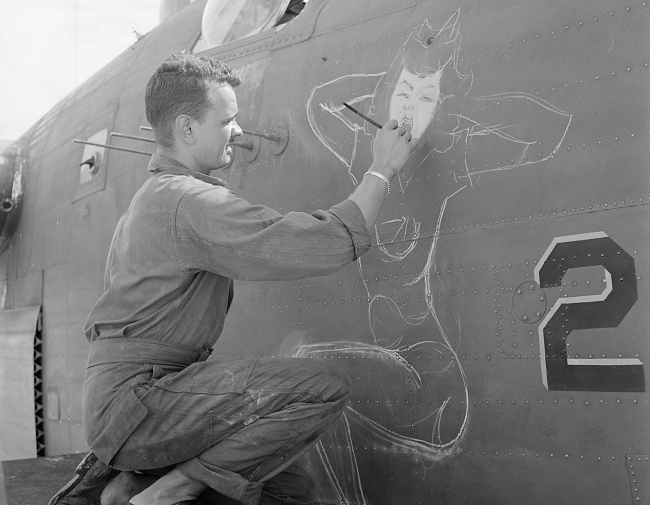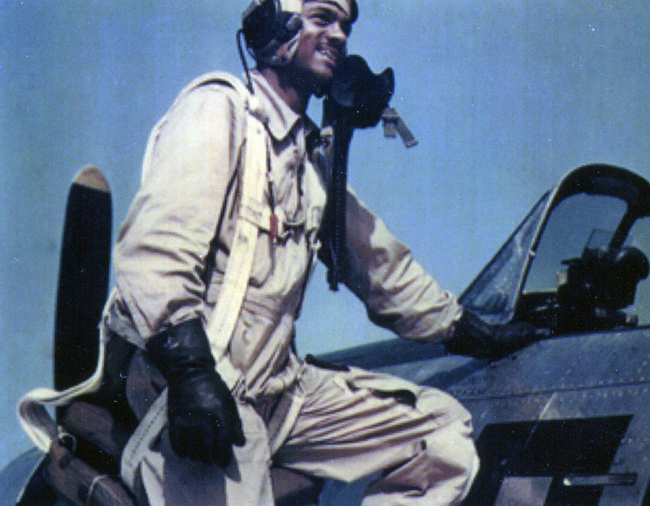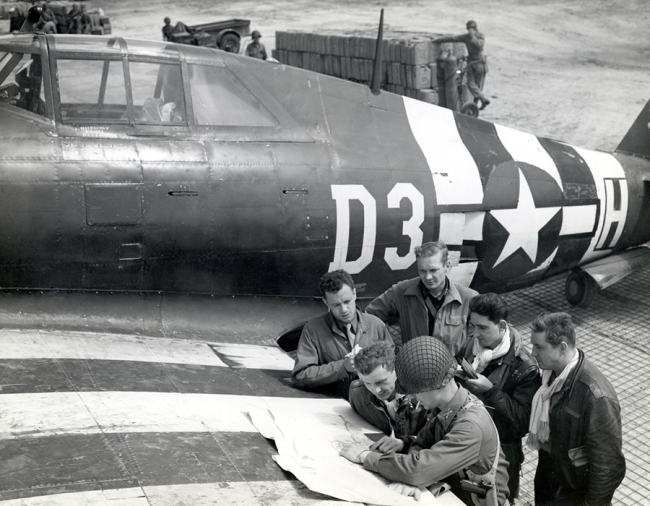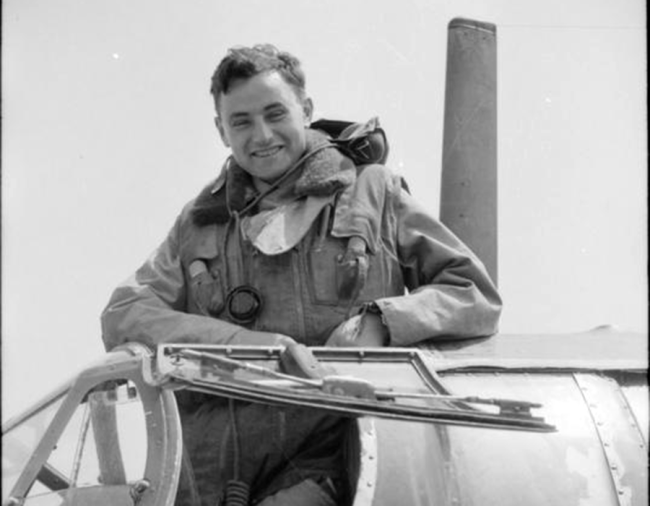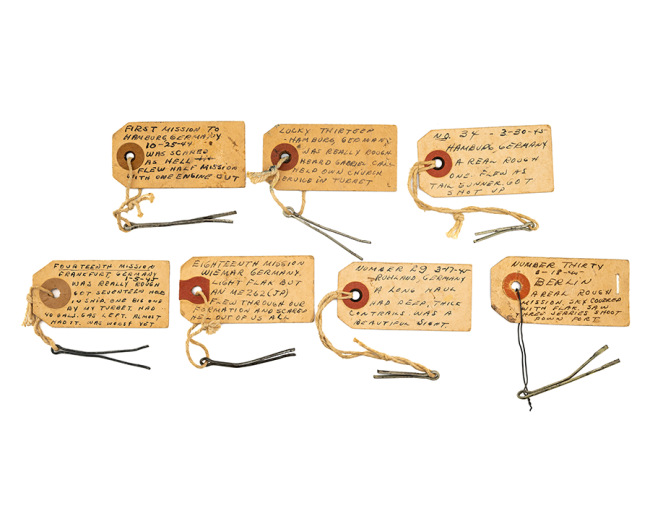Top Photo: Bombardier Captain Harold Romm’s membership card with Stalag Luft III censor marks on the reverse. Gift in Memory of Harold Room, 2019.209.011
During World War II, thousands of Americans reluctantly became members of the exclusive “Caterpillar Club.” The qualifications were simple: Was a parachute used to save your life? You’re in!
Those admitted into the Caterpillar Club had had their lives literally swinging in the balance, using parachutes after bailing out of disabled aircraft. Named for the silkworm caterpillar, which produced the silk originally used to make parachutes, the club encapsulates the precariousness of its member’s experiences with its motto: “Life depends on a silken thread.”
The largest parachute producer, Irving (or Irvin) Air Chute Company, had factories all over the world by 1933. Founder Leslie Irvin was a Hollywood stuntman and developer of the modern parachute. By 1939, 45 foreign countries were using Irving silk chutes, including Germany. While Irving remained the largest supplier, Switlik Parachute Company based in New Jersey received five Army-Navy “E” Awards for excellence in production in supplying the military with thousands of parachutes weekly during the war. Beginning in 1940, producers began to use DuPont nylon as an alternative to silk, which had largely been sourced from Japan. Nearly 3,000 workers at Pioneer Parachute Company, which evolved from a domestic silk mill in Manchester, Connecticut, turned out 300 parachutes a day during peak wartime production.
While aircrews were forced to bail out all over the world during the war, operationally, the highest percentage of forced parachute descents took place in Europe; large numbers of them were successful. The air war and aerial bombardment of German-occupied Europe resulted in record numbers of airmen forced to bail out of airplanes, many into enemy territory. The Schweinfurt–Regensburg mission on August 17, 1943, resulted in more than 250 Americans being taken prisoner after 60 of the 376 bombers were shot down by flak or fighters or were lost due to malfunction. Often, it was a combination of the three, and most disabled aircraft went down ablaze, filled with fuel, oil, and explosives. Collisions and explosions were common. Aircrews did not willingly jump from planes: bailout was one’s last chance for survival.
Bailout was often the most traumatic moment in an airman’s career, whether on the first mission or the last. Physically, it was jarring; 445th Bombardment Group pilot Lieutenant Jim Baynham likened it to “flipping a towel really hard and you were on the end of it.” Unlike paratroopers, who were mission-driven and trained to jump from aircraft, for aircrews, bailing out was undesired and unrehearsed. In 1943 and 1944, members of the 8th Air Force received minimal instruction on how to use a parachute. This part of the training was limited to a one-hour talk on the basic functions of a parachute. Depending on the circumstances, these sessions might also be accompanied by a lecture on evasion, sometimes delivered by one of the few who managed to make it out of enemy-controlled territory and back to base. However, these guest lectures were not universally conducted. Thinking and talking about these outcomes were not “palatable.” Sergeant William Livingstone, a 100th Bombardment Group gunner, recalled that when asked if they would get a practice jump, his instructor remarked, “You have to do it perfectly the first time.”
In the actual event of a bailout, crews often had only moments to ready themselves for the inevitable. In some instances, men were oxygen deprived and half conscious. Some were paralyzed with fear at the thought of bailout or were too traumatized by their circumstances that they were stuck in place, unable to move. If they were lucky, they were coaxed or pushed out into the sky by fellow crewmembers. Getting close enough to the hatch often provided enough force to be pulled out by the slipstream. But other crews were blown out of the sky and in an instant were jettisoned from their ravaged aircraft. If they were wearing their parachutes and were conscious enough to pull the ripcord, they might survive. Staff Sergeant Norman Bussel, a 447th Bombardment Group radio operator, recalled hanging in the thick white mist of the clouds and thinking, “You’re dead. You’re absolutely dead.” Like Bussel, most downed airmen remembered the absolute silence of their bailout. After missions marked by cacophony and chaos, floating in the parachute was devoid of noise. Lieutenant Oscar Richard III of the 384th Bombardment Group wrote, “In contrast to the ear-splitting vibration of a dying four-engine bomber, it was eerily quiet.”
The Caterpillar Club predates the carnage of World War II. It began in 1922, when Leslie Irvin agreed to gift every person whose life was saved by one of his parachutes a gold pin, initially shaped as caterpillars with ruby eyes (later gilt and garnet, and then 10-karat gold-filled and enamel). Irvin honored his agreement, and over 34,000 gold pins were distributed by the end of World War II, though the number of survivors was estimated to be much higher. The other major parachute manufacturers joined in to honor their survivors: Switlik Parachute Company, Pioneer Parachute Company, Standard Parachute Corporation, and others produced variations of the club’s award, usually a pin shaped like a caterpillar. Each company maintained registers of members, as did Wright Field—and in 1943, with the club’s numbers exploding, the Caterpillar Club incorporated officially. Office space and administrative assistance with applications, credentials, and correspondence was provided by Stanley Switlik.
Switlik’s syndicated comic Ripcord illustrated facts about parachutes, featured specific club members, and included details about club eligibility. As part of the application process, downed airmen had to apply to the parachute company or to the incorporated club relating the circumstances of their bailout. Sometimes a crewmember or commanding officer would submit the names of entire crews that had bailed out. Officially, wearing the badge on the uniform was against US Army regulations. An August 1944 96th Bombardment Group Station Bulletin out of Snetterton, England, notes under the heading “Wearing of Unauthorized Insignia” that “it has come to the attention of Headquarters that there have been numerous instances where personnel have been wearing either embroidered or metallic insignia denoting membership in the ‘Caterpillar Club.’” Ironically, two weeks later the same station bulletin included a notice about how to apply for membership in the Caterpillar Club. It specified that while one should include details of the jump, they should not violate security regulations. And one should include their home address if they desired their pins be sent there because “membership cards will be sent immediately but badges are not available in U.K. and may not be ready for several months.”
Some prospective members opted to apply from their new temporary addresses in German prisoner-of-war camps. Official letters flowed to and from POW camps in Europe from parachute makers, notifying downed airmen that they qualified as members of the esteemed Caterpillar Club. Switlik’s flowery letter stated that “the credentials and pin are symbolic of the precepts for the promotion of air-safety and the spirit of good fellowship.” Irving’s letter begins: “Congratulations … It is indeed a pleasure to welcome you as a member of the Caterpillar Club.” For the caged birdmen, the Caterpillar Club award was a hard-earned distinction. While the pins were the most visible sign of membership, according to one Royal Air Force airman, Caterpillar Club member Ken Wright, members received three things: a membership card or certificate, a pin, and continued life. Staff Sergeant Anthony Hoch, who bailed out of a B-17 during a February 1945 mission, later reported to the Binghamton Press, “But I wasn’t thinking about my membership when we heard the command to bail.”
The Caterpillar Club exists to this day. Famous members include Charles Lindbergh, General Jimmy Doolittle, and Senator John Glenn. With more than 100,000 members, they accept but do not solicit new members.
-

Navigator 2nd Lieutenant David Rodrigue’s Caterpillar Club pin. Gift of David Rodrigue, 2002.326.001
-

Lieutenant Linwood Inscoe’s membership card. Gift in Memory of Linwood St. Clair Inscoe Jr., 2002.632.005
-

Bombardier Captain Harold Romm’s membership card with Stalag Luft III censor marks on the reverse. Gift in Memory of Harold Room, 2019.209.011
-

Card that accompanied bombardier 2nd Lieutenant Irwin Joseph Stovroff’s caterpillar badge. Gift of Irwin Stovroff 2014.622.053
-

Membership letter of Technical Sergeant Roscoe Mitchell Pierson. Gift of Eugenia Carey, 2014.471.038
-

Membership letter of Technical Sergeant Roscoe Mitchell Pierson. Gift of Eugenia Carey, 2014.471.038
Making Masters of the Air Podcast
Join The National WWII Museum each week for the Making Masters of the Air podcast presented by Boeing to dive deeper into the making of Masters of the Air and explore the history behind the Apple TV+ series. The Making Masters of the Air podcast is co-hosted by Playtone’s Kirk Saduski and Donald Miller, author of the book Masters of the Air.
New podcast episodes available Fridays.
Subscribe now via Apple Podcasts or Spotify.
Kim Guise
Kimberly Guise holds a BA in German and Judaic Studies from the University of Massachusetts Amherst. She also studied at the Universität Freiburg in Germany and holds a masters in Library and Information Science (MLIS) from Louisiana State University. Kim is fluent in German, reads Yiddish, and specializes in the American prisoner-of-war experience in World War II.
Cite this article:
MLA Citation:
APA Citation:
Chicago Style Citation:
